
Benedict of Nursia, often known as Saint Benedict, was an Italian Catholic monk. He is famed in the Catholic Church, the Eastern Orthodox Church, the Lutheran Churches, the Anglican Communion, and Old Catholic Churches. In 1964, Pope Paul VI declared Benedict a patron saint of Europe.
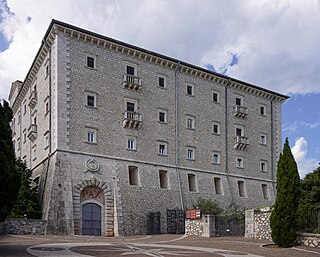
Monte Cassino is a rocky hill about 130 kilometres (80 mi) southeast of Rome, in the Latin Valley, Italy, 2 kilometres west of Cassino and at an elevation of 520 m (1,710 ft). Site of the Roman town of Casinum, it is widely known for its abbey, the first house of the Benedictine Order, having been established by Benedict of Nursia himself around 529. It was for the community of Monte Cassino that the Rule of Saint Benedict was composed.

Assisi is a town and commune of Italy in the Province of Perugia in the Umbria region, on the western flank of Monte Subasio.
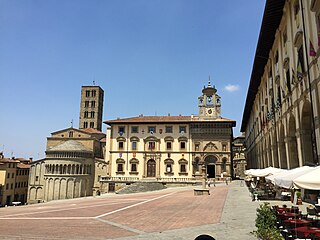
Arezzo is a city and comune in Italy and the capital of the province of the same name located in Tuscany. Arezzo is about 80 kilometres southeast of Florence at an elevation of 296 metres (971 ft) above sea level. As of 2022, the population was about 97,000.

The Papal Basilica of Saint Paul Outside the Walls is one of Rome's four major papal basilicas, along with the basilicas of Saint John in the Lateran, Saint Peter's, and Saint Mary Major, as well as one of the city’s Seven Pilgrim Churches. The basilica is the conventual church of the adjacent Benedictine abbey. It lies within Italian territory, but the Holy See owns the basilica and it is part of the Vatican's extraterritoriality.

Spoleto is an ancient city in the Italian province of Perugia in east-central Umbria on a foothill of the Apennines. It is 20 km (12 mi) south of Trevi, 29 km (18 mi) north of Terni, 63 km (39 mi) southeast of Perugia; 212 km (132 mi) southeast of Florence; and 126 km (78 mi) north of Rome.
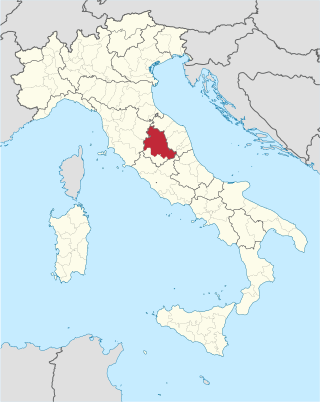
The province of Perugia is the larger of the two provinces in the Umbria region of Italy, comprising two-thirds of both the area and population of the region. Its capital is the city of Perugia. The province covered all of Umbria until 1927, when the province of Terni was carved out of its southern third. The province of Perugia has an area of 6,334 km2 covering two-thirds of Umbria, and a total population of about 660,000. There are 59 comuni in the province. The province has numerous tourist attractions, especially artistic and historical ones, and is home to the Lake Trasimeno, the largest lake of Central Italy. It is historically the ancestral origin of the Umbri, while later it was a Roman province and then part of the Papal States until the late 19th century.
Pier Antonio Mezzastris was an Italian painter of the Quattrocento, painting in a somewhat provincial style for the time.
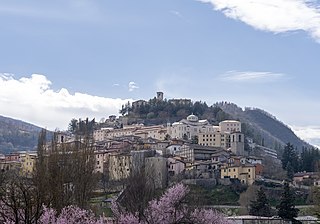
Cascia is a town and comune (municipality) of the Italian province of Perugia in a rather remote area of the mountainous southeastern corner of Umbria. It is about 21 km from Norcia on the road to Rieti in the Lazio (63 km). It is also very close to Terni.

The Basilica of Saint Francis of Assisi is the mother church of the Roman Catholic Order of Friars Minor Conventual in Assisi, a town in the Umbria region in central Italy, where Saint Francis was born and died. It is a papal minor basilica and one of the most important places of Christian pilgrimage in Italy. With its accompanying friary, Sacro Convento, the basilica is a distinctive landmark to those approaching Assisi. It has been a UNESCO World Heritage Site since 2000.

The Abbey of Sassovivo is a Benedictine monastery in Umbria in central Italy. Administratively, it is a frazione of the comune of Foligno.

San Benedetto is a late-Baroque architecture, Roman Catholic church and former Benedictine monastery in the city Catania, Sicily, southern Italy. The church facade faces Via Crociferi, parallels across via San Benedetto the former-Jesuit church of San Francesco Borgia, and both are about a block south along Crociferi from the church and convent of San Giuliano. Entrance to church and monastery appear to be through Piazza Asmundo #9 near the apse of the church.

The Abbey of Saint Scholastica, also known as Subiaco Abbey, is located just outside the town of Subiaco in the Province of Rome, Region of Lazio, Italy; and is still an active Benedictine abbey, territorial abbey, first founded in the 6th century AD by Saint Benedict of Nursia. It was in one of the Subiaco caves that Benedict made his first hermitage. The monastery today gives its name to the Subiaco Congregation, a grouping of monasteries worldwide that makes up part of the Order of Saint Benedict.
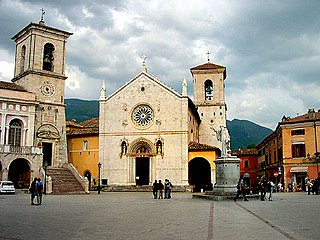
The Abbey of St. Benedict on the Mountain, also known as Norcia Abbey, is a Benedictine community of monks located in southeastern Umbria, just outside the city of Norcia, Italy. Originally founded in the 10th century, the abbey was closed by the Napoleonic Army as part of its suppression of religious communities. A new monastic community was founded in 1998 by a group of American monks which was formally established the following year as a priory directly under the supervision of the Abbot Primate.

The church of Sant'Afra in Brescia, also known as the church of Sant'Afra in Sant'Eufemia, is located on Corso Magenta, near Piazzale Arnaldo.

Gualdo Tadino Cathedral is a Roman Catholic cathedral in Gualdo Tadino in Umbria, Italy, dedicated to Saint Benedict of Nursia. Formerly a Benedictine abbey church, it became a cathedral in 1915, and is now a co-cathedral in the diocese of Assisi-Nocera Umbra-Gualdo Tadino.

San Ponziano is a romanesque-style, Former-Benedictine monastery and church located in Spoleto, Province of Perugia, region of Umbria, Italy. The site is dedicated to St. Ponziano, the patron saint of Spoleto.

A series of major earthquakes struck Central Italy between the Marche and Umbria regions in October 2016. The third quake on 30 October was the largest in Italy in 36 years, since the 1980 Irpinia earthquake.
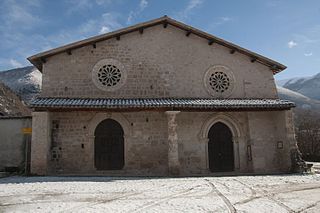
San Salvatore, also known as the pieve di Santa Maria, was a Roman Catholic church in Campi, a frazione in the comune of Norcia, Italy. Its existence is first documented in the 11th century, when it was a Benedictine church dedicated to Saint Mary. The church was rebuilt in the 14th century and enlarged in the late 15th century. In 1493, the church was rededicated to the Holy Saviour. The church was an example of Romanesque architecture, and its interior was richly decorated with frescoes. The building collapsed due to damage sustained in the October 2016 Central Italy earthquakes, and only part of the perimeter wall and a pile of rubble survived.
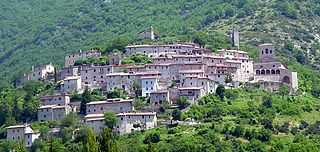
Campi, also known as Campi di Norcia, is a frazione of the comune of Norcia in the province of Perugia, Umbria, Italy. The medieval village has a population of around 200 people. Many of its landmarks, including the Church of San Salvatore, were heavily damaged during the October 2016 Central Italy earthquakes.
























